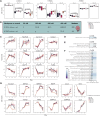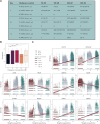Citalopram exposure of hESCs during neuronal differentiation identifies dysregulated genes involved in neurodevelopment and depression
- PMID: 39055655
- PMCID: PMC11269147
- DOI: 10.3389/fcell.2024.1428538
Citalopram exposure of hESCs during neuronal differentiation identifies dysregulated genes involved in neurodevelopment and depression
Abstract
Selective serotonin reuptake inhibitors (SSRIs), including citalopram, are widely used antidepressants during pregnancy. However, the effects of prenatal exposure to citalopram on neurodevelopment remain poorly understood. We aimed to investigate the impact of citalopram exposure on early neuronal differentiation of human embryonic stem cells using a multi-omics approach. Citalopram induced time- and dose-dependent effects on gene expression and DNA methylation of genes involved in neurodevelopmental processes or linked to depression, such as BDNF, GDF11, CCL2, STC1, DDIT4 and GAD2. Single-cell RNA-sequencing analysis revealed distinct clusters of stem cells, neuronal progenitors and neuroblasts, where exposure to citalopram subtly influenced progenitor subtypes. Pseudotemporal analysis showed enhanced neuronal differentiation. Our findings suggest that citalopram exposure during early neuronal differentiation influences gene expression patterns associated with neurodevelopment and depression, providing insights into its potential neurodevelopmental impact and highlighting the importance of further research to understand the long-term consequences of prenatal SSRI exposure.
Keywords: DNA methylation; citalopram; depression; epigenetics; human embryonic stem cells; multi-omics; neurodevelopment; single-cell RNA-seq.
Copyright © 2024 Spildrejorde, Leithaug, Samara, Aass, Sharma, Acharya, Nordeng, Gervin and Lyle.
Conflict of interest statement
The authors declare that the research was conducted in the absence of any commercial or financial relationships that could be construed as a potential conflict of interest.
Figures






Similar articles
-
Multi-omics approach reveals dysregulated genes during hESCs neuronal differentiation exposure to paracetamol.iScience. 2023 Aug 28;26(10):107755. doi: 10.1016/j.isci.2023.107755. eCollection 2023 Oct 20. iScience. 2023. PMID: 37731623 Free PMC article.
-
Effects of prenatal exposure to (es)citalopram and maternal depression during pregnancy on DNA methylation and child neurodevelopment.Transl Psychiatry. 2023 May 5;13(1):149. doi: 10.1038/s41398-023-02441-2. Transl Psychiatry. 2023. PMID: 37147306 Free PMC article.
-
Perinatal exposure to the selective serotonin reuptake inhibitor citalopram alters spatial learning and memory, anxiety, depression, and startle in Sprague-Dawley rats.Int J Dev Neurosci. 2016 Nov;54:39-52. doi: 10.1016/j.ijdevneu.2016.08.007. Epub 2016 Aug 31. Int J Dev Neurosci. 2016. PMID: 27591973
-
The impact of antidepressants on human neurodevelopment: Brain organoids as experimental tools.Semin Cell Dev Biol. 2023 Jul 30;144:67-76. doi: 10.1016/j.semcdb.2022.09.007. Epub 2022 Sep 15. Semin Cell Dev Biol. 2023. PMID: 36115764 Review.
-
Pharmacokinetic-pharmacodynamic relationship of the selective serotonin reuptake inhibitors.Clin Pharmacokinet. 1996 Dec;31(6):444-69. doi: 10.2165/00003088-199631060-00004. Clin Pharmacokinet. 1996. PMID: 8968657 Review.
Cited by
-
Functional Connectome of Superagers Reveals Early Markers of Resilience and Vulnerability to Alzheimer's Disease.bioRxiv [Preprint]. 2025 Jul 22:2025.07.20.665707. doi: 10.1101/2025.07.20.665707. bioRxiv. 2025. PMID: 40777400 Free PMC article. Preprint.
References
-
- Aryee M. J., Jaffe A. E., Corrada-Bravo H., Ladd-Acosta C., Feinberg A. P., Hansen K. D., et al. (2014). Minfi: a flexible and comprehensive Bioconductor package for the analysis of Infinium DNA methylation microarrays. Bioinformatics 30, 1363–1369. 10.1093/bioinformatics/btu049 - DOI - PMC - PubMed
LinkOut - more resources
Full Text Sources
Molecular Biology Databases

